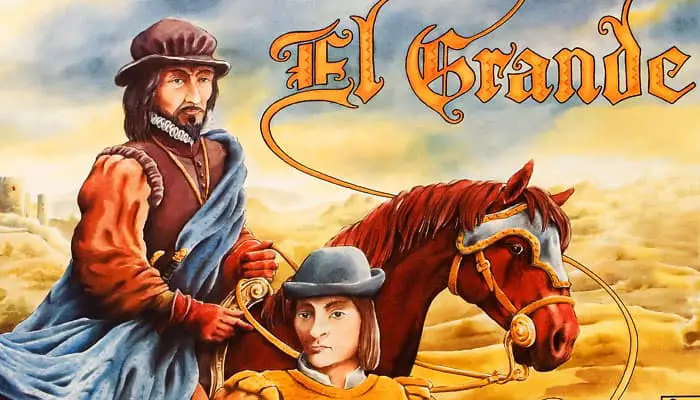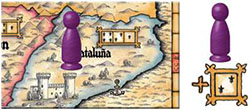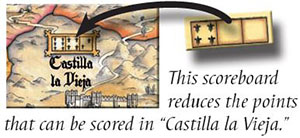
Components

- Game board
- 5 Grandes (the large cubes) in 5 colors
- 155 Caballeros (the small cubes) in 5 colors (31 per color)
- 1 King (large black pawn)
- 1 Round marker (small black cube)
- 65 Power cards in 5 colors (numbered 1-13 in each color)
- 45 Action cards
- 9 Region cards (with rule summary on the backs)
- 5 Secret disks with pointers
- 1 Castle (Castillo)
- 2 Mobile scoreboards with the values "8/4/0" and "4/0/0"
- 1 Sample game sheet
Game Board
The board shows the 9 regions of Spain, 1 space to hold the Castillo, the success track along the edge of the board, and a round track with 9 game rounds and 3 horizontal scoring tracks.
In each region, there is a scoreboard with 3 symbols, which show the values of the region, when it is scored. The player with the most Caballeros in a region scores the highest value, whoever has the second most scores the second value, etc.
Object of the Game
Players strategically place their Caballeros in regions to obtain points for majorities. At the end of the game, the player with the most points wins.
Game Play

The game is played over 9 rounds, in which players place Caballeros from their Court into the regions on the board.
Every 3 rounds (after the 3rd, 6th, and 9th rounds), scoring occurs. The players with the most Caballeros in each region scores points, marked by moving their scoring marker forward on the scoring track.
Note: You may choose to play a shorter 6-round game. In a 6-round game, scoring occurs every 2 rounds. Skip rounds 1, 4, and 7 on the round track.
In each round, the following phases occur in the following order:
- Reveal Action cards
- Play Power cards
- Each player takes their turn
- End of round
- Scoring phase (only after rounds 3, 6, and 9)
1. Reveal Action Cards
Reveal the top Action card of each of the 5 Action card stacks.

Example: The top card of each Action card stack has been revealed.
Each player will perform one of these actions in the present round. Players may now take a moment to make themselves familiar with the available Action cards.
2. Play Power Cards
Beginning with the player who has the start player marker, each player, in clockwise order, plays a Power card from their hand, faceup in front of themselves. A player may not play a Power card bearing the value of a Power card that was already played in the same round.
The playing of Power cards determines two things, both of which come into effect in step 3.
Example: Ramon (red) has the start player marker. He begins the round by playing a 7. Benita (blue) is the next player clockwise. She may play anything but a 7. She plays a 3. Gabriel (yello) is next and may play anything but a 7 or a 3. He plays a 2. Ricarda (pink) is last and chooses to play an 8.

-

Turn Order
In step 3, the player who played the highest Power card takes the first turn. Then, the player with the second highest Power card plays, etc.
Note: Taking an earlier turn allows a player a better selection of Action cards.
Example: The turn order for this round is Ricarda (8), Ramon (7), Benita (3), Gabriel (2).
-

Supply
In step 3, the number of Caballero
 symbols in the center of your Power card indicates how many Caballeros you may take from the Province into your Court.
symbols in the center of your Power card indicates how many Caballeros you may take from the Province into your Court.Note: The higher the number of the Power card, the lower the supply. Caballeros must be in your Court before you can send them to the regions of Spain.
Example: Ricarda will receive 2 Caballeros from the Province to place in her Court; Ramon, 3 Benita and Gabriel, 5 each.
3. Each player takes their turn
The player who played the highest Power card begins. Once this player has completed his turn, the next player in Power card turn order plays, etc. Each player takes only one turn in each round.
Each player performs the following steps during his turn:
A. Take Caballeros from the Province into one's Court
To begin your turn, take a number of Caballeros from the Province into your Court equal to the number of Caballero symbols on your Power card.
Important: If there are not enough Caballeros in the Province, you may choose to take Caballeros from regions on the board (not from the Castillo). You may choose to take fewer Caballeros than the Power card indicates.
Example:

Benita may take up to 5 Caballeros into her Court, however she has only 3 Caballeros remaining in the Province. She takes those 3 into her Court and 2 more from regions on the board.
If Benita did not wish to remove any of her Caballeros from the board, she could have chosen to only take the 3 Caballeros from the Province.
B. Execute an Action card
Now you choose one of the revealed Action cards. Take the card and execute the following two actions:
-

The Special Action
You may execute the special action on the card. In doing so, you must perform the complete action, whenever possible. Using the card to the right as an example, you must score all 5-point regions, even if this would cause an opponent to score more points than you.
Some cards, however, indicate that you are allowed to partially execute the action, for example, the Intrigue card: "You may place 4 Caballeros".
You may also choose to not perform the special action at all.
-

Place Caballeros
The number of Caballeros shown on the Action card indicates how many Caballeros
 you place on the board.
you place on the board.- You may only use Caballeros from your Court. If there are not enough Caballeros in your Court to place the number you are allowed, then those placements are forfeited.
- You may only place Caballeros in regions neighboring the King's region (not the King's region itself).
- You may also choose to place Caballeros in the Castillo.
You may choose the order in which you execute the special action and place caballeros. However, you must complete them one at a time. You may not, for example, place some of your Caballeros, execute the Special action, then place the rest of your Caballeros (or vice versa).
Example 1

Ricarda chooses the King's Card. She decides to execute the special action first. She moves the King to "Castilla la Nueva", which becomes the new King's region. Ricarda then places 5 Caballeros from her Court onto the board.
She may place these Caballeros in any region neighboring the King's region, which are (at this time): "Aragon", "Castilla la Vieja", "Granada", "Sevilla", and "Valencia". She may also choose to place Caballeros in the Castillo.
Example 2

Benita chooses the depicted action card "Special Scoring". She decides to place Caballeros on the board first. The action card allows her to place 3 Caballeros from her Court.
The King's region is "Galicia", meaning that Benita may place her Caballeros in "Castilla la Vieja", "Pais Vasco", or the Castillo. She places 2 Caballeros in "Pais Vasco" and one in the Castillo.
Then, Benita executes the special action and scores all 5-point regions.
These are "Aragon, " "Pais Vasco, " and "Valencia. " She must score all 5-point regions, even those where an opponent scores more points than her. The Castillo is not scored by this card (see below).
After you are finished using the Action card, place this Action card facedown underneath the corresponding stack. This card will not be available for the other players.
Then, the next player in Power card turn order takes their turn, as explained above.
Some Important Concepts And Special Features:
The Castillo

The Castillo is not a region. When the rules or cards mention a "region" or "regions", the Castillo is excluded.
Whenever you place Caballeros on the board, you may choose to place some or all of them in the Castillo. It does not matter which region is the King's region.
Whenever you move Caballeros, you may not move them from the Castillo. You may, however, choose to move Caballeros from a region into the Castillo.
Whenever you place Caballeros in the Castillo, you must tell your opponents how many Caballeros you are adding to the Castillo. No player may look inside the Castillo or move Caballeros out of the Castillo. Note: It is therefore useful to memorize the number of Caballeros each player has placed in the Castillo.
During each general scoring (after rounds 3, 6, and 9), as well as during special Castillo scoring - and only then - the Castillo is lifted. After a special Castillo scoring, the Caballeros found in the Castillo remain there. After general scoring, Caballeros are moved to specific regions.
The king, the King's region, and the neighboring regions
The region the King occupies is called the King's region. There are 3 rules that govern the King's region:
The King's Region Is Taboo!
This is one of the most important rules of the game!.
Nothing in the King's region may ever be changed! No Caballeros, Grandes, or scoreboards may be placed in or removed from the King's region. There are no exceptions!
Caballeros Placed On The Board.
Caballeros may only be placed in the regions neighboring the King's region (or placed in the Castillo). Never in the King's region itself!
King's Bonus
During general scoring or a special scoring affecting the King's region, the player who has the most Caballeros in the King's region scores an additional 2 points. If there is a tie for the most Caballeros in a region, this bonus is not awarded!
"Castilla la Nueva" is the King's region. Neighboring regions are all those regions directly adjacent to the King's region.
4. End Of Round
After all players have completed their turns, perform the following to prepare for the next round:
-
Place any remaining Action cards facedown underneath the corresponding stack.

Example: In a 4-player game, 1 Action card is left unused. This card is placed underneath its stack. The top card of each stack is now hidden.
-
The player with the lowest Power card takes the start player marker.
-
All players discard their Power card to their personal facedown Power card discard pile. Discarded Power cards can not be used again.

Example: played the lowest Power card. He takes the start player marker. In the next round, he will be the first player to play a Power card. The other players will follow in clockwise order.
Note: In each round, you will have one fewer Power card to choose from. Make sure to leave yourself a variety of Power cards for future rounds. (Incidentally, it is guaranteed that you will always have a Power card that you are able to play).
-
Move the round marker 1 space down.
-

If the round marker is moved to the next number, a new round begins, as described above.
-

If the round marker is moved to a fleur-de-lis, general scoring occurs (see below). This will happen after the 3rd, 6th, and 9th rounds. Once general scoring is complete, move the round marker 1 space down and begin the following round.
-
5. Scoring

If the round marker is moved to a fleur-de-lis, a general scoring occurs.
In each general scoring, perform the following steps:
- Choose a secret region.
- Score the Castillo.
- Move the Caballeros from the Castillo to the players' chosen regions.
- Score the individual regions.
The scoring key on the right, next to the round track, serves as an overview.
1. Choose A Secret Region

The region you choose indicates where your Caballeros will be moved during step 3, "Move the Caballeros from the Castillo".
You must now choose the region your Caballeros will be moved to after the Castillo has been scored. To do so, move the arrow on the secret disc to the region you have chosen.

Important: These Caballeros may not be moved to multiple regions. You must clearly choose one region. Remember that the King's region is taboo (Caballeros may not be moved there).
2. Score The Castillo

After all players have chosen a secret region, the Castillo is scored. Lift the Castillo and determine which players had the most Caballeros in the Castillo.
The player with the most Caballeros scores 5 points. The player with the second most scores 3 points. The player with the third most scores 1 point.
If there is a tie, all tied players score points according to the next lowest position. A player who has no Caballeros in the Castillo scores no points.

Note: In a 2-player game, only the player with the most Caballeros in the Castillo will score points. In a 3-player game, only the players with the most and second most Caballeros in the Castillo will score points. Players track their points by moving their scoring markers forward on the score track.
3. Move The Caballeros From The Castillo

All players reveal their secret disc. Each player moves their Caballeros from the Castillo to the region they chose on their secret disc.
Important: Any player who chose the King's region moves their Caballeros from the Castillo back into their Court.
Return the Castillo to its normal position on the board.

4. Score The Individual Regions

Each region is scored in the order depicted on the scoring key. As with the Castillo, points are awarded to those players who have the most Caballeros in each region.
The scoreboard in each region indicates how many points are awarded to those players with the most (second most, third most) Caballeros in the region.
Important: The Grandes only serve to identify each player's home region, and are not counted when determining majority.

Note: In a 2-player game, only first place points are awarded. Only the player with the most Caballeros in a region will score points. In a 3-player game, only first and second place points are awarded. Only the players with the most and second most Caballeros in a region will score points.
As with the Castillo, tied players score points according to the next lowest position. Players with no Caballeros in a region do not participate in the scoring of that region.
King's Bonus

Whenever the King's region is scored (whether during general or special scoring), the player with the most Caballeros (no ties!) scores an additional 2 points.
Example:

"Cataluma" is the King's region. Gabriel has 2 Caballeros. Ramon has 1 Caballero.
Therefore Gabriel is alone in first place, and scores 4 points according to the region's scoreboard, plus an additional 2 points for being first place in the King's region.
Ramon scores 2 points for second place. No other players are present, so third place points are not awarded.
Home Region Bonus

The home region bonus is similar to the King's region bonus.
If a player has the most Caballeros in his home region (no ties!) when it is scored (whether during general or special scoring), he scores an additional 2 points.
Remember: Do not count The Grande when determining majority.
Example

"Granada" is Ramon's home region (his Grande is there). He has 4 Caballeros there. Gabriel and Ricarda each have only 1 Caballero.
Ramon scores 4 points for first place, and an additional 2 points for being first place in his home region.
Gabriel and Ricarda are tied for second place, and each score points for the next lowest position, third place: 1 point.
Note: It is possible for a player to receive the King's bonus and his home bonus in the same region.
Mobile Scoreboard
The two mobile scoreboards can be placed and moved with certain Action cards, causing regions to either appreciate or depreciate in value. Each region may only host one mobile scoreboard at a time.
Once all regions have been scored, move the round marker 1 space down, and begin the new round.

End of the Game
The game ends after the third general scoring. The player with the most points wins, and is dubbed "El Grande". If there is a tie for most points, these players rejoice in a shared victory!
Continue Reading





